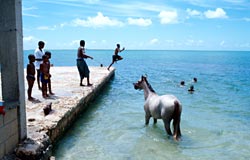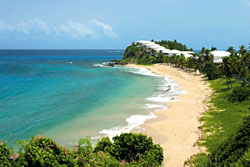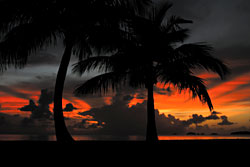Barbuda is one of those very few islands in the Caribbean that remains--and probably will remain for some time--so undeveloped as to seem positively deserted at times. With the exception of the guests of the island's small number of accommodations, the population seems largely to consist of the graceful Fregata magnificens, or frigate bird. As the birds possess a marked preference for the northwest lagoon, Barbuda's seemingly endless white and pink sand beaches are left to the peaceful wanderings of those lucky enough to sojourn here.
Activities on Barbuda are appropriately relaxed, including beachcombing (on the northeastern Atlantic coast), fishing and hunting and, at the island's resorts, golf, tennis, snorkeling, diving, or simply soaking up the sun and the calm. Points of interest include the Frigate Bird Sanctuary, the truly noteworthy pink and white sand beaches, and an abundance of  shipwrecks and beautiful reefs. Barbuda can be reached easily from Antigua, either by air (a 20-minute flight, twice daily) or by boat (in three hours). The island is home to the luxurious K-Club, Coco Point Lodge and Hotel Palmetto resorts, as well as to a number of other hotels and comfortable guest houses.
shipwrecks and beautiful reefs. Barbuda can be reached easily from Antigua, either by air (a 20-minute flight, twice daily) or by boat (in three hours). The island is home to the luxurious K-Club, Coco Point Lodge and Hotel Palmetto resorts, as well as to a number of other hotels and comfortable guest houses.
Barbuda's history has been intimately tied to that of Antigua for centuries. The first early attempts to settle Barbuda (by both the British and French) were failures, and it wasn't until 1666 that the British established a colony strong enough to survive the ravages of both nature and the Caribs. In 1680, four years before he began cultivating sugar on Antigua, Christopher Codrington was granted (with his brother John) a lease to land in Barbuda. With subsequent leases that granted them additional rights to the substantial wreckage along Barbuda's reefs, they became the island's preeminent family. For much of the eighteenth century the Codrington land on Barbuda was used to produce food and to supply additional slave labour for the Codrington sugar plantations on Antigua, and so the Barbuda's fortunes rose and fell with those of its larger neighbour. Testament to the influence of the Codringtons remains today, both in the island's place names and in its architectural remains. On Barbuda's highest point (124 feet) are the ruins of the Codrington estate, Highland House, and on the island's south coast still sits the 56-foot high Martello castle and tower, a fortress that was used both for defense and as a vantage from which to spot valuable shipwrecks on the outlying reefs.

Barbuda's Frigate Bird Sanctuary is located in the island's northwestern lagoon and is accessible only by boat. The sanctuary contains over 170 species of birds and is home to over 5,000 frigate birds. Fregata magnificens, the most aerial of waterbirds, possesses the largest wingspan (four to five feet) in proportion to its body size of any bird in the world. It is also known as the man o' war bird, and the comparison to warships is a particularly apt one--with its superior size and flight capabilities, the frigate bird harasses less agile flyers like pelicans, egrets, and cormorants until they drop their catch. The male frigate is marked by its red throat pouch, which it can inflates as part of its courtship behaviour and as a defensive display. Courting takes place in the fall, and chicks hatch late in the year.

Beaches in Antigua and Barbuda
There are 365 beaches on Antigua, one for each day of the year. The great majority rest inside the calm, protected waters of the island's Caribbean side. All are open to the public, and so the challenge posed to a visitor is not how to gain access to the best of them but simply how to locate the beach that suits one's taste. Exploring on your own is the best way to do this, although it is wise to bring a companion along to particularly isolated locations. Antiguans are understandably reluctant to divulge their own favorites, so here are a number of good starters. Be sure to acquire specific directions before you go.
 Northwest Coast:
Northwest Coast:
Dickenson Bay and Runaway Bay, located along the island's developed northwestern coast, are the place to go for those who want the fully-loaded resort beach experience. The beaches most convenient to St. John's are Fort James, a locally-popular public beach, and Deep Bay. Galley Bay attracts surfers during the winter months and a joggers during the evening. The series of four crescent beaches at Hawksbill are also highly regarded, one of which is nudist.
 Southwest and South Coast:
Southwest and South Coast:
The beaches of the hilly southwest corner of Antigua are generally less developed than those around St. John's further north. On the road that winds along this coast are Fryes Bay, Darkwood Beach, and the beaches around Johnsons Point. Rendezvous Bay and especially Doigs Beach, both located on the central southern coast at Rendezvous Bay, are especially quiet beaches worth the rough travel necessary to reach them. Pigeon Point, near English Harbour Town, is a convenient balm after a day at Nelson's Dockyard.
East Coast:
On the southeast corner of the island is Half Moon Bay, now a National Park and a good choice for a family outing. Long Bay, on the easternmost point of the island, is another good choice for families, as it is completely protected by its reef.
No comments:
Post a Comment